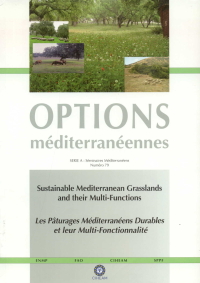| Article précédent | p. 335-339 | Article suivant |
Differential response to drought, disturbance and increasing temperature of endemic and non-endemic species of a mountain-Mediterranean grassland
Autochthonous and widely distributed plant species coexist in most natural pastured grasslands. The aim of this work was to differentiate autochthonous and widely distributed species of a mountain-Mediterranean grassland regarding their ability to face drought and disturbance. A group of species from a natural pasture in the Nebrodi mounts (Sicily) were analysed for their response to light, temperature, water availability and cutting. The species were pot-cultivated and subjected to different experimental treatments. Growth, allocation and plant architecture were determined during the experiments; photosynthetic activity, transpiration and water use efficiency at different temperatures and PPFD were determined by gas-exchange analysis. Local taxa were characterized by different strategies to face water stress, whereas non-endemic pabular species showed higher growth rates and better ability to withstand cutting. The species studied showed different responses to increasing temperatures, pointing out the relevant effects that climatic changes may induce on grassland species composition.
Dans les pâturages naturels les espèces autochtones coexistent avec celles à large distribution. Le but de ce travail a été de diversifier les espèces autochtones d'un pâturage méditerranéen-montagnard par rapport aux espèces largement distribuées, pour leur tolérance à l'aridité et aux perturbations. Un groupe d'espèces des Monts Nebrodi (Sicile) a été cultivé en pot et étudié en termes de réponse à la lumière, température, disponibilité en eau et coupe. On a évalué la croissance, répartition de biomasse et architecture des plantes ; on a aussi mesuré l'activité photosynthétique, transpiration et efficacité d'utilisation de l'eau. Les taxons locaux se sont diversifiés dans les stratégies pour faire face aux carences hydriques, tandis que les espèces fourragères non endémiques ont montré un taux de croissance plus élevé et une meilleure tolérance à la coupe. On a observé des réponses différentes à la température, ce qui indique l'importance des changements climatiques sur la composition des prairies.
- [ Afficher ]
- [ Télécharger ]
- [ Exporter la citation ]
Vous pouvez télécharger la citation au format :
- [ Imprimer ]
-
Mots-clés
CROISSANCE, EXPERIMENTATION, PATURAGES, REGION MEDITERRANEENNE, REPONSE DE LA PLANTE, RESISTANCE AUX FACTEURS NUISIBLES, SICILE, STRESS, VARIETE INDIGENE, VARIETE INTRODUITECiter cet article
Mingo A., Cristaudo A., Vitale L., Magliulo V. Differential response to drought, disturbance and increasing temperature of endemic and non-endemic species of a mountain-Mediterranean grassland. In : Porqueddu C. (ed.), Tavares de Sousa M.M. (ed.). Sustainable Mediterranean grasslands and their multi-functions . Zaragoza : CIHEAM / FAO / ENMP / SPPF, 2008. p. 335-339. (Options Méditerranéennes : Série A. Séminaires Méditerranéens; n. 79). 12. Meeting of the Sub-Network on Mediterranean Forage Resources of the FAO-CIHEAM Inter-regional Cooperative Research and Development Network on Pastures and Fodder Crop, 2008/04/09-12, Elvas (Portugal). http://om.ciheam.org/om/pdf/a79/00800673.pdf



